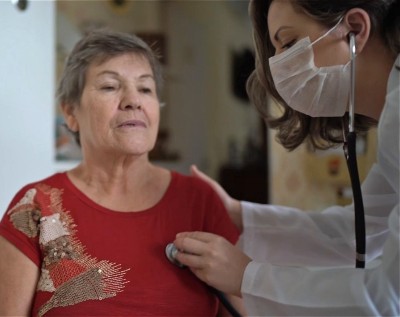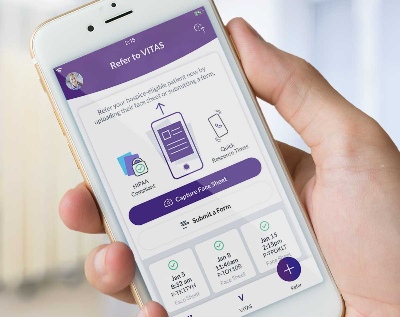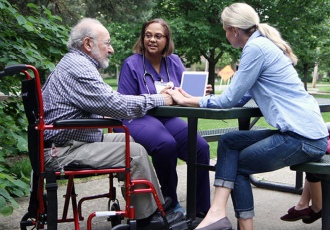By Henri Nammour, MD, Regional Medical Director, VITAS Healthcare
Winter has arrived, and with winter comes lower temperatures. The increased cold presents particular danger to people with advanced lung disease (ALD) in general and chronic obstructive pulmonary disease (COPD) in particular, leading to increased exacerbation frequency and worsening of symptoms.
With the chronic and life-limiting nature of these conditions, patients with ALD and COPD can benefit immensely from timely palliative care and hospice referral and involvement.
Decreased Temperatures, Increased Exacerbations
Evidence in the literature shows the seasonality of COPD exacerbations. A retrospective analysis of the large-scale TIOSPIR® trial found “marked seasonal variation in COPD exacerbations, hospitalization, and mortality.” The authors note that “in the northern hemisphere, the peak for exacerbations is early winter, followed by the peak for hospitalizations in midwinter.”15 An analysis of numerous COPD-related studies worldwide saw a pattern of “clear seasonality in COPD [primary care] consultations” and “increased hospital admissions for COPD exacerbations.”8
As the temperature drops, the rate of COPD exacerbations increases. A study comparing meteorological variables with health system registry data showed an inverse correlation between temperature and COPD exacerbation rate.14
A Prevalent But Underdiagnosed Disease
In 2020, 12.5 million people reported a diagnosis of COPD, chronic bronchitis, or emphysema.6 COPD is the fifth disease-related cause of death.5 In 2019, there were close to 536,000 COPD hospitalizations and 1,320,000 COPD emergency department visits.4
These are staggering numbers, but COPD remains a disease with under-reported prevalence and potential underdiagnosis; according to the CDC, more than 50% of adults with low pulmonary function were not aware that they had COPD.2
With early diagnosis and proper use of advance care planning (ACP) and goals of care (GOC) discussion, the opportunity to involve palliative care early on in the disease course and hospice at the appropriate time can make a tremendous difference in ALD/COPD patients’ and their families’ and caregivers’ lives.
An Opportunity for Improvement
Hospice is underutilized in ALD/COPD patients. While more COPD patients are using hospice and palliative care, they are a small minority of this large patient population. A significant proportion of patients with COPD are not hospice users; consequently, they often receive a disproportionate amount of aggressive interventions at the end of life.13
While there has been a general trend of increased use of palliative care and hospice among COPD patients in the past two decades, “only a minority of patients with COPD die at home or in hospice. Early PC [palliative care] involvement in patients with severe COPD may improve the end-of-life experience and increase hospice use.”16 A greater proportion of decedents from pulmonary disease die in the hospital than individuals dying of cancer, cardiovascular disease, cerebrovascular disease, or dementia.7
For ALD/COPD patients, discussion of ACP and GOC are typically provided too late, if at all. They were less likely to have advance directives in place, leading to higher and more aggressive healthcare utilization near end-of-life that offers little benefit in the face of advanced disease.11
What Patients Want
Patients with advanced respiratory illness want to learn more about end-of-life care. However, patients “report feeling frustrated by poor communication and discussion surrounding ACP, and often feel that important therapeutic and symptomatic goals are not discussed.”3
Notably and concerningly, fewer than one-third of patients with COPD and their caregivers had even heard of palliative care. Only a minority of these patients received formal palliative care referrals, and many are only referred after ICU admission or prior to hospice initiation.7
ACP happens rarely in advanced lung disease, with only about 20% of patients engaging in these conversations on average and almost 30% of these discussions occurring in the last three days of life.9 With timely and appropriate discussion of ACP and GOC, patients were less likely to receive unnecessarily intensive care towards end of life.11
Hospice and Palliative Care Improve Clinical Outcomes
When asked about their goals and needs, patients with advanced illness desired controlling pain and symptoms, avoiding inappropriate prolongation of the dying process, having a sense of control, relieving burdens on family, and strengthening relationships with loved ones.
Greater utilization of hospice during the last 6 months of life is associated with improved patient experience and clinical outcomes.10 Patients with ALD and their families experience improved overall satisfaction with their care, improved symptom control and quality of life, fewer unnecessary procedures and interventions near the end of life and higher likelihood of dying at home. Earlier hospice referral has even been associated with prolonged survival.1
Hospice Cost Savings: A Matter of Dollars and Sense
Per a recent report from NORC, hospice provides significant cost savings. The cost for Medicare beneficiaries who used hospice was lower than the cost for those who did not use hospice, with a 20% lower average total cost of care seen in beneficiaries with respiratory disease.12
NORC's findings show clear quantitative cost-saving benefit with the use of hospice in patients with respiratory diseases; however, the principal benefits of hospice remain the improvements in quality of life and in patient, family, and caregiver satisfaction.
Hospice Can Help
Hospice alleviates symptom burden and improves quality of life for patients suffering from ALD and COPD; it promotes goal-concordant care with decreased readmissions, reduced in-hospital mortality, lower total costs of care, and improvement in patient satisfaction.
Related: Hospice Eligibility Guidelines for Patients with ALD/COPD
If your patient does not yet qualify for hospice, bringing palliative care onboard early in the patient's disease course can help facilitate advance care planning and goals of care discussion, and ease a patient's transition into hospice when the time is right.
The prevalence of ALD in general and COPD in particular means that there is a large patient population that is not currently taking advantage of the myriad benefits that hospice can provide. There is ample opportunity for hospice to improve the quality of life for millions of patients and for their caregivers and loved ones.
1. Adler ED, Goldfinger JZ, Kalman J, Park ME, Meier DE. Palliative care in the treatment of advanced heart failure. Circulation. 2009;120(25):2597-2606. doi:10.1161/circulationaha.109.869123
2. Basics about COPD. Centers for Disease Control and Prevention. June 30, 2023. https://www.cdc.gov/copd/basics-about.html.
3. Brown CE, Jecker NS, Curtis JR. Inadequate palliative care in chronic lung disease. an issue of health care inequality. Annals of the American Thoracic Society. 2016;13(3):311-316. doi:10.1513/annalsats.201510-666ps
4. COPD trends brief - burden. COPD Trends Brief - Burden | American Lung Association. https://www.lung.org/research/trends-in-lung-disease/copd-trends-brief/copd-burden.
5. COPD trends brief - mortality. COPD Trends Brief - Mortality | American Lung Association. https://www.lung.org/research/trends-in-lung-disease/copd-trends-brief/copd-mortality.
6. COPD trends brief - prevalence. COPD Trends Brief - Prevalence | American Lung Association. https://www.lung.org/research/trends-in-lung-disease/copd-trends-brief/copd-prevalence.
7. Cross SH, Ely EW, Kavalieratos D, Tulsky JA, Warraich HJ. Place of death for individuals with chronic lung disease. Chest. 2020;158(2):670-680. doi:10.1016/j.chest.2020.02.062
8. Donaldson G, Wedzicha J. The causes and consequences of seasonal variation in COPD exacerbations. International Journal of Chronic Obstructive Pulmonary Disease. Published online 2014:1101. doi:10.2147/copd.s54475
9. Jabbarian LJ, Zwakman M, van der Heide A, et al. Advance care planning for patients with chronic respiratory diseases: A systematic review of preferences and practices. Thorax. 2017;73(3):222-230. doi:10.1136/thoraxjnl-2016-209806
10. Kleinpell R, Vasilevskis EE, Fogg L, Ely EW. Exploring the Association of Hospice Care on patient experience and outcomes of care. BMJ Supportive & Palliative Care. 2016;9(1). doi:10.1136/bmjspcare-2015-001001
11. Lee RY, Curtis JR, Kross EK. Physician orders for life-sustaining treatment and ICU admission near the end of life—reply. JAMA. 2020;324(6):608. doi:10.1001/jama.2020.8654
12. NORC at the University of Chicago (2023). Value of Hospice in Medicare. Available at: https://www.nhpco.org/wp-content/uploads/Value_Hospice_in_Medicare.pdf
13. Shen JJ, Ko E, Kim P, et al. Life-sustaining procedures, palliative care consultation, and do-not resuscitate status in dying patients with COPD in US hospitals. Journal of Palliative Care. 2018;33(3):159-166. doi:10.1177/0825859718777375
14. Tseng C-M, Chen Y-T, Ou S-M, et al. The effect of cold temperature on increased exacerbation of chronic obstructive pulmonary disease: A nationwide study. PLoS ONE. 2013;8(3). doi:10.1371/journal.pone.0057066
15. Wise RA, Calverley PM, Carter K, Clerisme-Beaty E, Metzdorf N, Anzueto A. Seasonal variations in exacerbations and deaths in patients with COPD during the TIOSPIR® trial. International Journal of Chronic Obstructive Pulmonary Disease. 2018;Volume 13:605-616. doi:10.2147/copd.s148393
16. Yaqoob ZJ, Al-Kindi SG, Zein JG. Trends and disparities in hospice use among patients dying of COPD in the United States. Chest. 2017;151(5):1183-1184. doi:10.1016/j.chest.2017.02.030


